load capacity NISSAN LEAF 2020 Owner´s Manual
[x] Cancel search | Manufacturer: NISSAN, Model Year: 2020, Model line: LEAF, Model: NISSAN LEAF 2020Pages: 596, PDF Size: 4.33 MB
Page 87 of 596

CAUTION
As the quick charge connector is
heavier in comparison to the other
charge connectors, allowing it to drop
could cause damage to the vehicle or
charge connector or personal injury.
When removing the connector, be sure
to pull it out straight and as carefully as
possible.
HOW TO CHARGE/DISCHARGE
USING QUICK CHARGE PORT (if so
equipped)
V2X (vehicle to everything) enables the EV
to supply electric power to a home or a
building, etc.
“V2X ” includes all of the following:
• Vehicle to home (V2H)
• Vehicle to building (V2B)
• Vehicle to grid (V2G)
• Vehicle to load (V2L)
• Vehicle to vehicle (V2V)
V2X charge/discharge uses a V2X device.
WARNING
• Always use a quick charger/V2X de-
vice that is compatible with the LEAF.
Using an incompatible quick
charger/V2X device may cause a fire
or malfunction resulting in serious
personal injury or death.
• Before starting the quick charge/V2X
charge, carefully read the instruc-
tions provided on the quick charger/
V2X device and make sure the quick
charge connector is properly con-
nected and locked. Failure to connect
or operate the quick charger cor-
rectly could cause damage to the ve-
hicle or the charging equipment.
NOTE:
• Charging/discharging using quick charge port is possible (even several
times a day) if the battery temperature
is not near the red zone. If the battery
temperature reaches the red zone, in
order to protect the battery, charging/
discharging is not allowed and the
power limitation mode will be trig-
gered. For additional information, refer
to “Li-ion battery temperature gauge”
in the “EV Overview” and “Instruments
and controls” section of this manual. • When the Li-ion battery available
charge/discharge and the Li-ion bat-
tery capacity are shown on the quick
charger unit or V2X device, the read-
ings may differ from the Li-ion battery
available charge/discharge/capacity
reading shown on the vehicle’s display.
CH-38Charging
Page 442 of 596
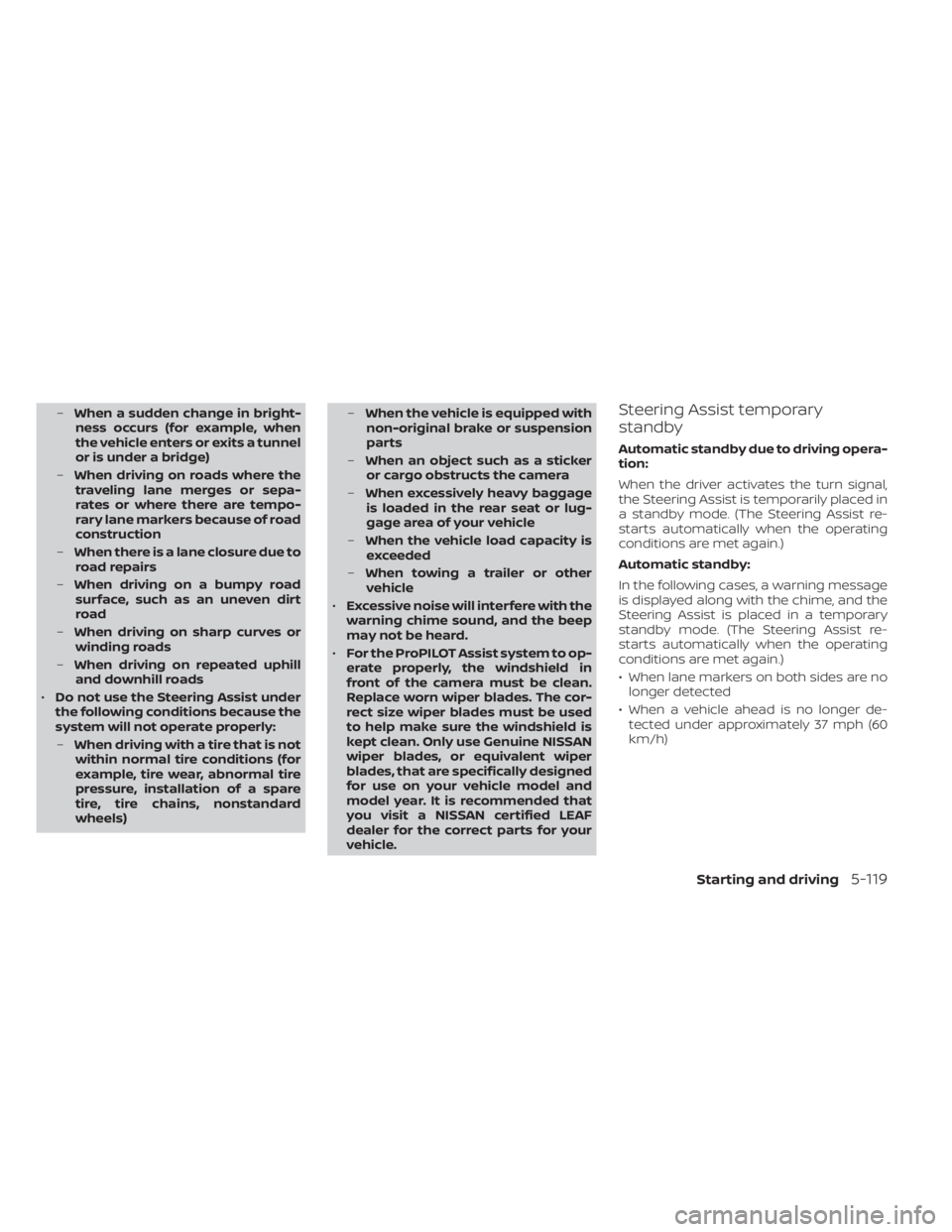
–When a sudden change in bright-
ness occurs (for example, when
the vehicle enters or exits a tunnel
or is under a bridge)
– When driving on roads where the
traveling lane merges or sepa-
rates or where there are tempo-
rary lane markers because of road
construction
– When there is a lane closure due to
road repairs
– When driving on a bumpy road
surface, such as an uneven dirt
road
– When driving on sharp curves or
winding roads
– When driving on repeated uphill
and downhill roads
• Do not use the Steering Assist under
the following conditions because the
system will not operate properly:
– When driving with a tire that is not
within normal tire conditions (for
example, tire wear, abnormal tire
pressure, installation of a spare
tire, tire chains, nonstandard
wheels) –
When the vehicle is equipped with
non-original brake or suspension
parts
– When an object such as a sticker
or cargo obstructs the camera
– When excessively heavy baggage
is loaded in the rear seat or lug-
gage area of your vehicle
– When the vehicle load capacity is
exceeded
– When towing a trailer or other
vehicle
• Excessive noise will interfere with the
warning chime sound, and the beep
may not be heard.
• For the ProPILOT Assist system to op-
erate properly, the windshield in
front of the camera must be clean.
Replace worn wiper blades. The cor-
rect size wiper blades must be used
to help make sure the windshield is
kept clean. Only use Genuine NISSAN
wiper blades, or equivalent wiper
blades, that are specifically designed
for use on your vehicle model and
model year. It is recommended that
you visit a NISSAN certified LEAF
dealer for the correct parts for your
vehicle.Steering Assist temporary
standby
Automatic standby due to driving opera-
tion:
When the driver activates the turn signal,
the Steering Assist is temporarily placed in
a standby mode. (The Steering Assist re-
starts automatically when the operating
conditions are met again.)
Automatic standby:
In the following cases, a warning message
is displayed along with the chime, and the
Steering Assist is placed in a temporary
standby mode. (The Steering Assist re-
starts automatically when the operating
conditions are met again.)
• When lane markers on both sides are no longer detected
• When a vehicle ahead is no longer de- tected under approximately 37 mph (60
km/h)
Starting and driving5-119
Page 549 of 596

•The Gross Vehicle Weight rating
(GVWR) is located on the
F.M.V.S.S./C.M.V.S.S certification
label. The vehicle weight capac-
ity is indicated on the Tire and
Loading Information label. Do
not load your vehicle beyond
this capacity. Overloading your
vehicle may result in reduced
tire life, unsafe operating condi-
tions due to premature tire fail-
ure, or unfavorable handling
characteristics and could also
lead to a serious accident. Load-
ing beyond the specified capac-
ity may also result in failure of
other vehicle components.
• Before taking a long trip, or
whenever you heavily load
your vehicle, use a tire pressure
gauge to ensure that the tire
pressures are at the specified
level. •
For additional information re-
garding tires, refer to “Impor-
tant Tire Safety Information”
(US) or “Tire Safety Informa-
tion” (Canada) in the Warranty
Information Booklet.
8-30
Maintenance and do-it yourself
Page 550 of 596
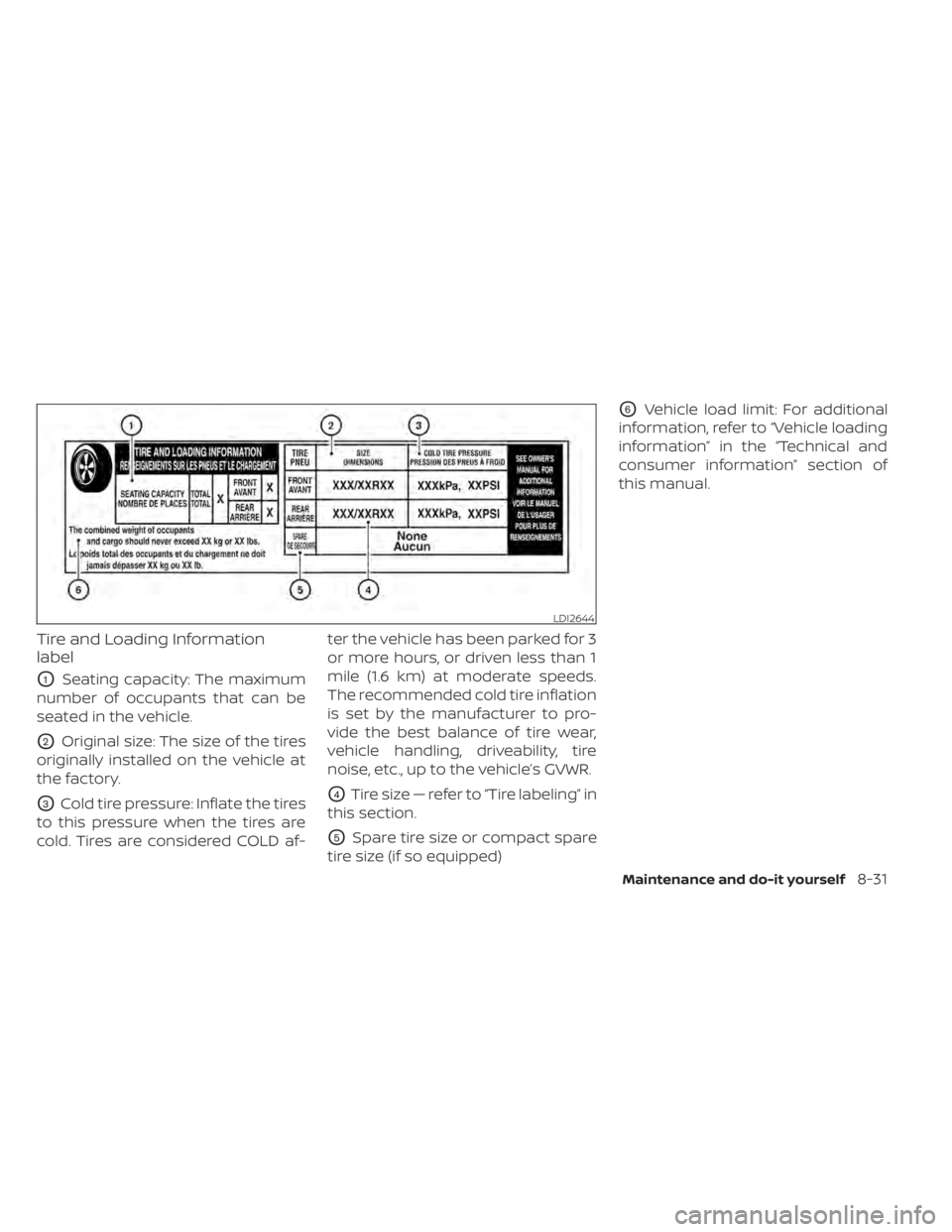
Tire and Loading Information
label
O1Seating capacity: The maximum
number of occupants that can be
seated in the vehicle.
O2Original size: The size of the tires
originally installed on the vehicle at
the factory.
O3Cold tire pressure: Inflate the tires
to this pressure when the tires are
cold. Tires are considered COLD af- ter the vehicle has been parked for 3
or more hours, or driven less than 1
mile (1.6 km) at moderate speeds.
The recommended cold tire inflation
is set by the manufacturer to pro-
vide the best balance of tire wear,
vehicle handling, driveability, tire
noise, etc., up to the vehicle’s GVWR.O4Tire size — refer to “Tire labeling” in
this section.
O5Spare tire size or compact spare
tire size (if so equipped)
O6Vehicle load limit: For additional
information, refer to “Vehicle loading
information” in the “Technical and
consumer information” section of
this manual.
LDI2644
Maintenance and do-it yourself8-31
Page 557 of 596
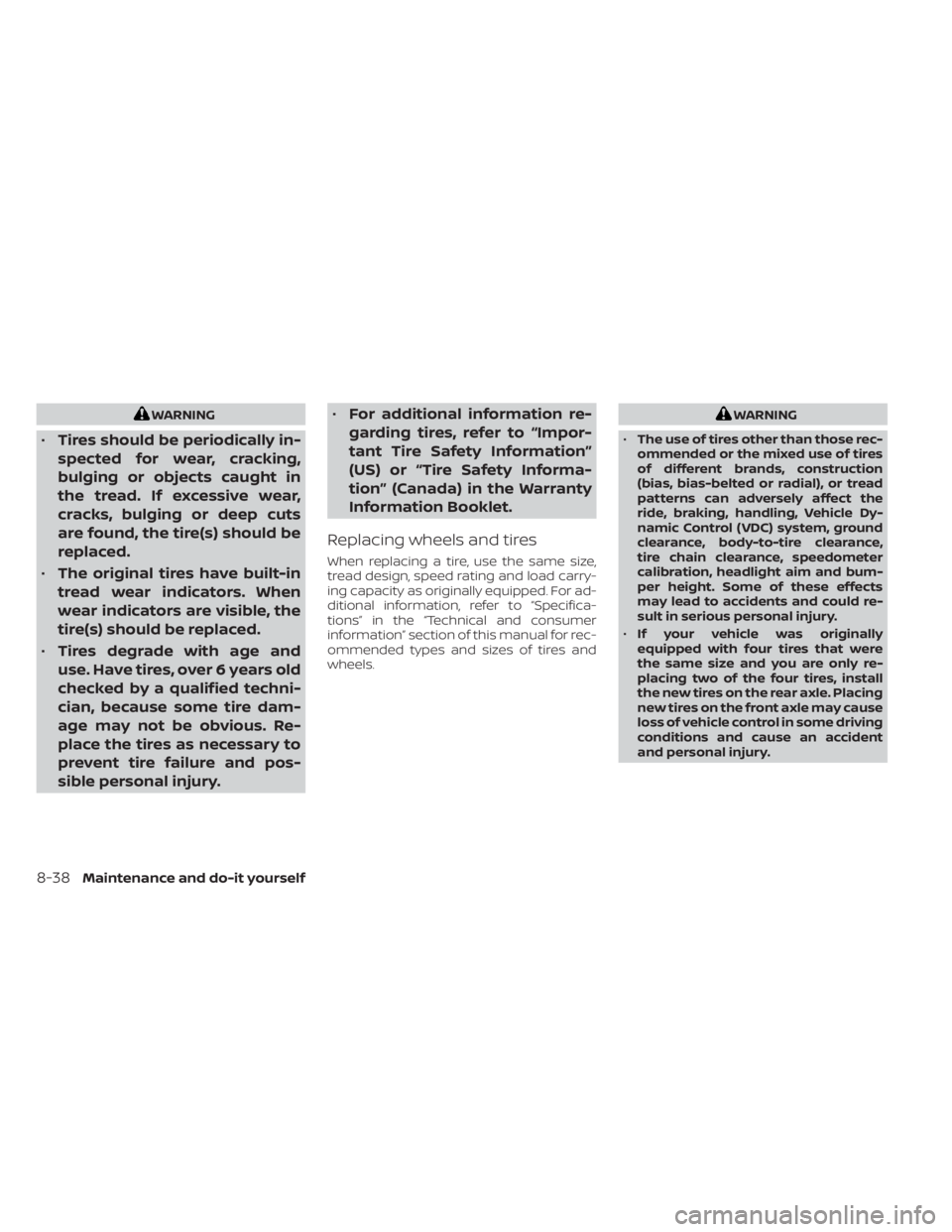
WARNING
•Tires should be periodically in-
spected for wear, cracking,
bulging or objects caught in
the tread. If excessive wear,
cracks, bulging or deep cuts
are found, the tire(s) should be
replaced.
• The original tires have built-in
tread wear indicators. When
wear indicators are visible, the
tire(s) should be replaced.
• Tires degrade with age and
use. Have tires, over 6 years old
checked by a qualified techni-
cian, because some tire dam-
age may not be obvious. Re-
place the tires as necessary to
prevent tire failure and pos-
sible personal injury. •
For additional information re-
garding tires, refer to “Impor-
tant Tire Safety Information”
(US) or “Tire Safety Informa-
tion” (Canada) in the Warranty
Information Booklet.
Replacing wheels and tires
When replacing a tire, use the same size,
tread design, speed rating and load carry-
ing capacity as originally equipped. For ad-
ditional information, refer to “Specifica-
tions” in the “Technical and consumer
information” section of this manual for rec-
ommended types and sizes of tires and
wheels.
WARNING
• The use of tires other than those rec-
ommended or the mixed use of tires
of different brands, construction
(bias, bias-belted or radial), or tread
patterns can adversely affect the
ride, braking, handling, Vehicle Dy-
namic Control (VDC) system, ground
clearance, body-to-tire clearance,
tire chain clearance, speedometer
calibration, headlight aim and bum-
per height. Some of these effects
may lead to accidents and could re-
sult in serious personal injury.
• If your vehicle was originally
equipped with four tires that were
the same size and you are only re-
placing two of the four tires, install
the new tires on the rear axle. Placing
new tires on the front axle may cause
loss of vehicle control in some driving
conditions and cause an accident
and personal injury.
8-38Maintenance and do-it yourself
Page 560 of 596
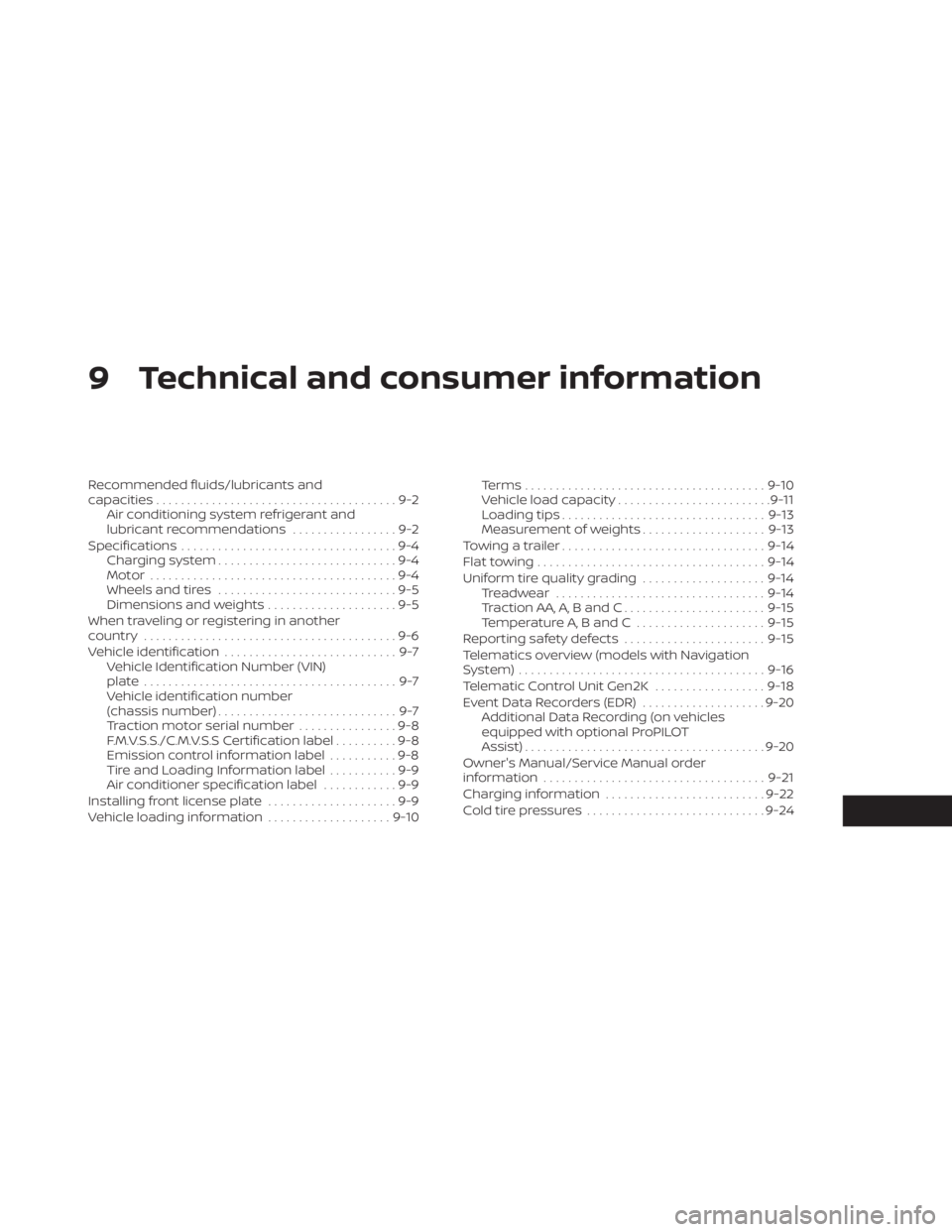
9 Technical and consumer information
Recommended fluids/lubricants and
capacities.......................................9-2
Air conditioning system refrigerant and
lubricant recommendations .................9-2
Specifications ...................................9-4
Charging system .............................9-4
Motor ........................................9-4
Wheels and tires .............................9-5
Dimensions and weights .....................9-5
When traveling or registering in another
country .........................................9-6
Vehicle identification ............................9-7
Vehicle Identification Number (VIN)
plate .........................................9-7
Vehicle identification number
(chassis number) .............................9-7
Traction motor serial number ................9-8
F.M.V.S.S./C.M.V.S.S Certification label ..........9-8
Emission control information label ...........9-8
Tire and Loading Information label ...........9-9
Air conditioner specification label ............9-9
Installing front license plate .....................9-9
Vehicle loading information ....................9-10Terms
....................................... 9-10
Vehicle load capacity ......................... 9-11
Loading tips ................................. 9-13
Measurement of weights ....................9-13
Towing a trailer ................................. 9-14
Flat towing ..................................... 9-14
Uniform tire quality grading ....................9-14
Treadwear .................................. 9-14
Traction AA, A, B and C ....................... 9-15
Temperature A, B and C .....................9-15
Reporting safety defects .......................9-15
Telematics overview (models with Navigation
System) ........................................ 9-16
Telematic Control Unit Gen2K ..................9-18
Event Data Recorders (EDR) ....................9-20
Additional Data Recording (on vehicles
equipped with optional ProPILOT
Assist) ....................................... 9-20
Owner's Manual/Service Manual order
information .................................... 9-21
Charging information .......................... 9-22
Cold tire pressures ............................. 9-24
Page 569 of 596
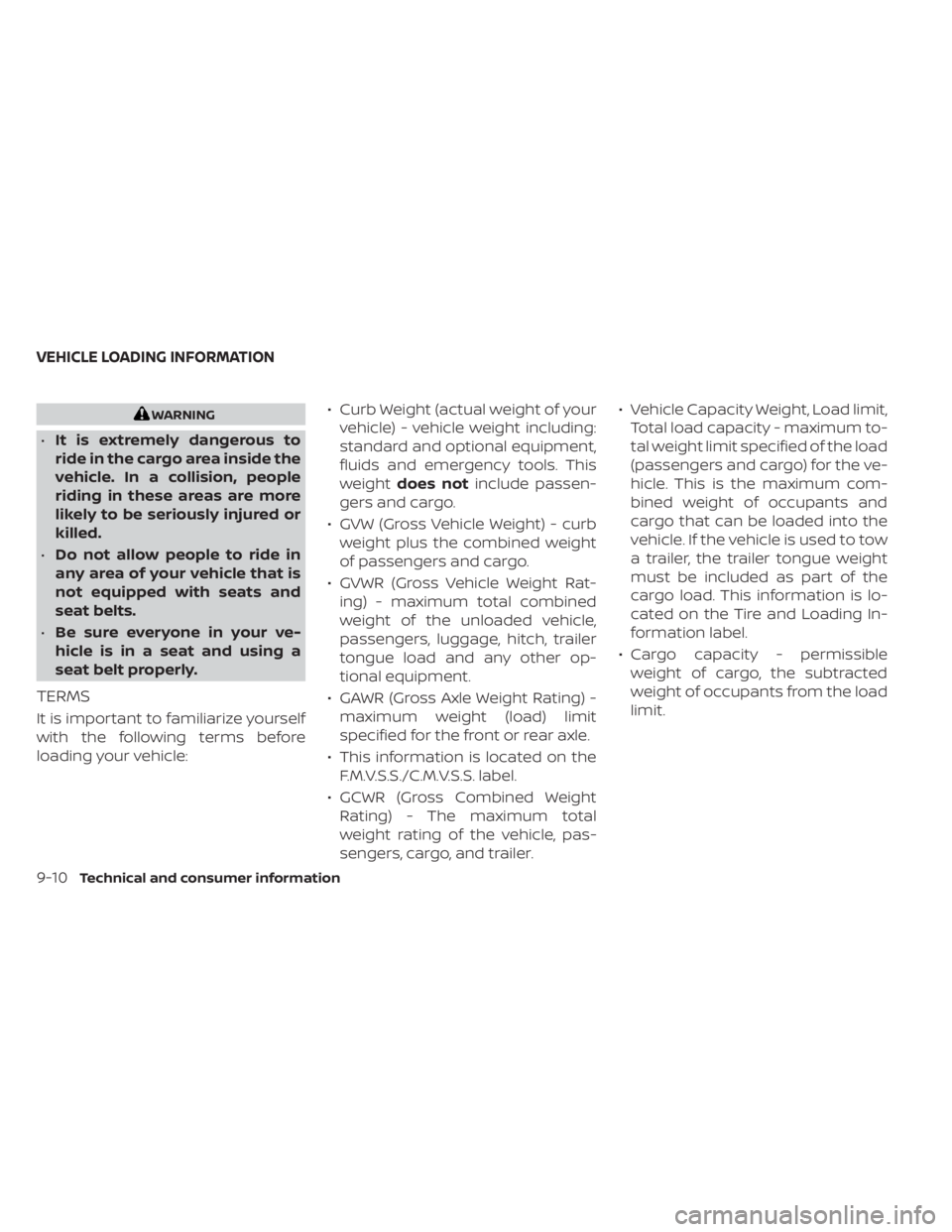
WARNING
•
It is extremely dangerous to
ride in the cargo area inside the
vehicle. In a collision, people
riding in these areas are more
likely to be seriously injured or
killed.
•Do not allow people to ride in
any area of your vehicle that is
not equipped with seats and
seat belts.
•Be sure everyone in your ve-
hicle is in a seat and using a
seat belt properly.
TERMS
It is important to familiarize yourself
with the following terms before
loading your vehicle: • Curb Weight (actual weight of your
vehicle) - vehicle weight including:
standard and optional equipment,
fluids and emergency tools. This
weight does not include passen-
gers and cargo.
• GVW (Gross Vehicle Weight) - curb weight plus the combined weight
of passengers and cargo.
• GVWR (Gross Vehicle Weight Rat- ing) - maximum total combined
weight of the unloaded vehicle,
passengers, luggage, hitch, trailer
tongue load and any other op-
tional equipment.
• GAWR (Gross Axle Weight Rating) - maximum weight (load) limit
specified for the front or rear axle.
• This information is located on the F.M.V.S.S./C.M.V.S.S. label.
• GCWR (Gross Combined Weight Rating) - The maximum total
weight rating of the vehicle, pas-
sengers, cargo, and trailer. • Vehicle Capacity Weight, Load limit,
Total load capacity - maximum to-
tal weight limit specified of the load
(passengers and cargo) for the ve-
hicle. This is the maximum com-
bined weight of occupants and
cargo that can be loaded into the
vehicle. If the vehicle is used to tow
a trailer, the trailer tongue weight
must be included as part of the
cargo load. This information is lo-
cated on the Tire and Loading In-
formation label.
• Cargo capacity - permissible weight of cargo, the subtracted
weight of occupants from the load
limit.
VEHICLE LOADING INFORMATION
9-10Technical and consumer information
Page 570 of 596
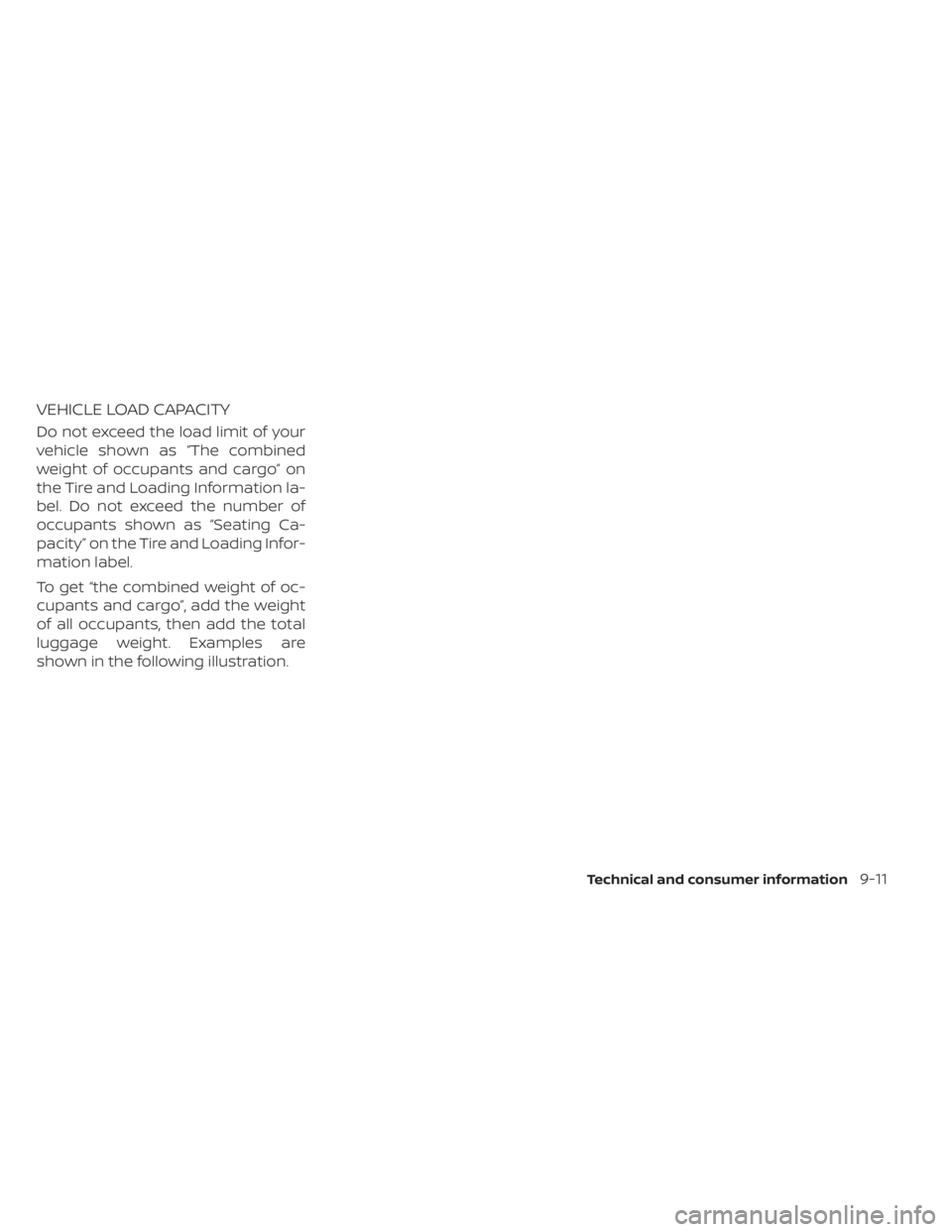
VEHICLE LOAD CAPACITY
Do not exceed the load limit of your
vehicle shown as “The combined
weight of occupants and cargo” on
the Tire and Loading Information la-
bel. Do not exceed the number of
occupants shown as “Seating Ca-
pacity” on the Tire and Loading Infor-
mation label.
To get “the combined weight of oc-
cupants and cargo”, add the weight
of all occupants, then add the total
luggage weight. Examples are
shown in the following illustration.
Technical and consumer information9-11
Page 571 of 596
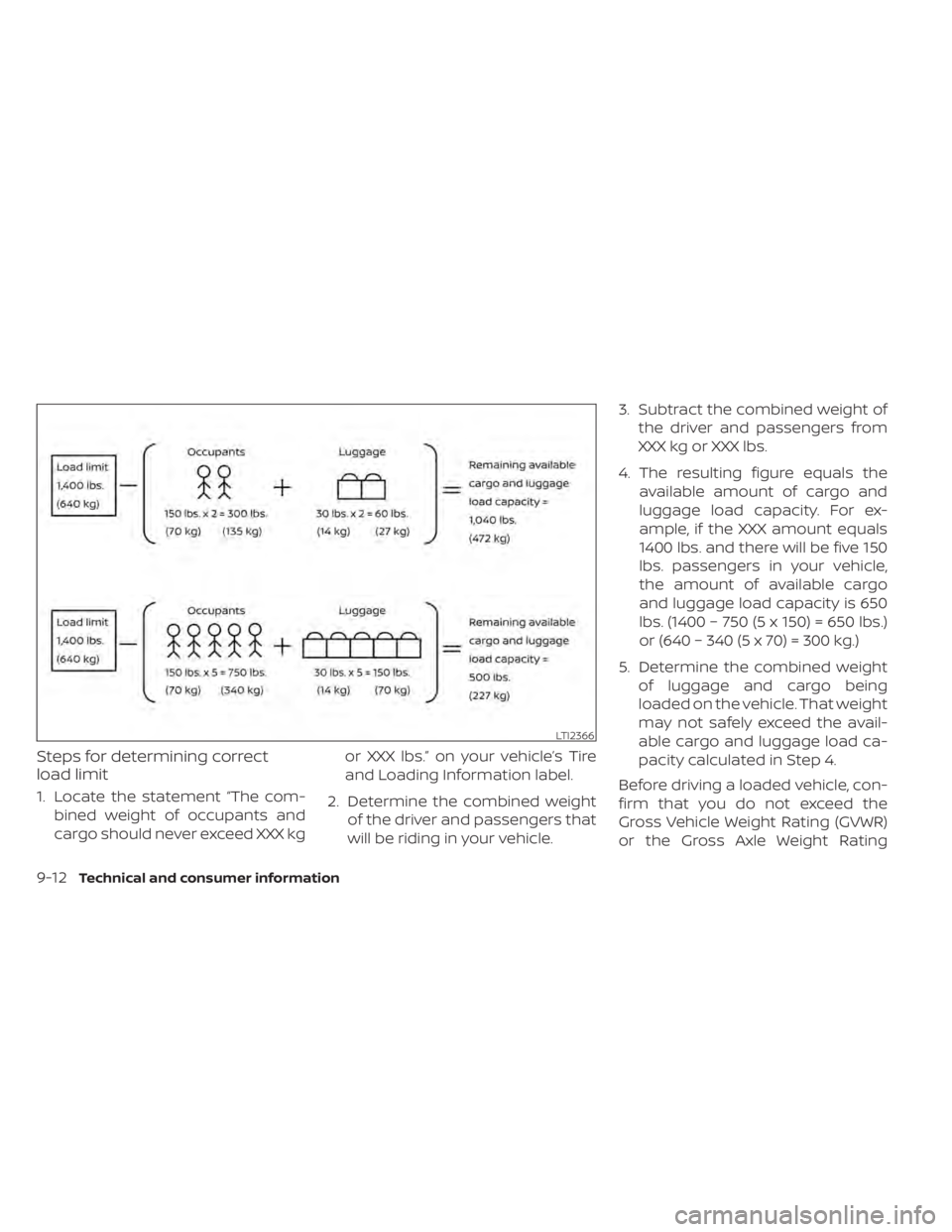
Steps for determining correct
load limit
1. Locate the statement “The com-bined weight of occupants and
cargo should never exceed XXX kg or XXX lbs.” on your vehicle’s Tire
and Loading Information label.
2. Determine the combined weight of the driver and passengers that
will be riding in your vehicle. 3. Subtract the combined weight of
the driver and passengers from
XXX kg or XXX lbs.
4. The resulting figure equals the available amount of cargo and
luggage load capacity. For ex-
ample, if the XXX amount equals
1400 lbs. and there will be five 150
lbs. passengers in your vehicle,
the amount of available cargo
and luggage load capacity is 650
lbs. (1400 − 750 (5 x 150) = 650 lbs.)
or (640 − 340 (5 x 70) = 300 kg.)
5. Determine the combined weight of luggage and cargo being
loaded on the vehicle. That weight
may not safely exceed the avail-
able cargo and luggage load ca-
pacity calculated in Step 4.
Before driving a loaded vehicle, con-
firm that you do not exceed the
Gross Vehicle Weight Rating (GVWR)
or the Gross Axle Weight Rating
LTI2366
9-12Technical and consumer information